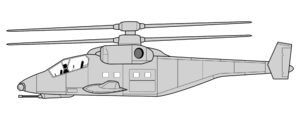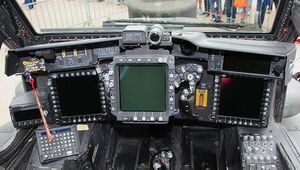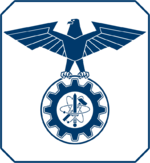KVI AVK-72
| AVK-72 | |
|---|---|

| |
| AVK-72E design drawing | |
| Role | Attack helicopter with transport capabilities |
| National origin | Khyragus |
| Manufacturer | KVI Aerospace |
| Designer | KVI Aerospace |
| First flight | 6 October 1969 |
| Introduction | 1972 |
| Status | In service |
| Primary user | Khyragusian Army Khyragusian Navy |
| Produced | 1969–present |
| Number built | 1,856 |
The AVK-72 is a Khyragusian twin-turboshaft helicopter gunship with a coaxial rotor system. It is designed to serve as a combination attack helicopter and utility helicopter capable of carrying 10 troops. It is heavily armed with a 30mm autocannon and eight hardpoints on the stub wing pylons. The KVI-74 is well-protected from a variety of threats, and has significant systems redundancy.
Development of the AVK-72 began in 1965 with the initiation Khyragusian Army's development program requesting a tactical utility helicopter. The program's requirements were later revised to include ground attack capabilities as well. In 1972, the design of the AVK-72 was finalized and approved by the Khyragusian Army for mass production.
Development
Origins and Early Development
In 1960s, the Khyragusian Army sought to improve its tactical mobility capabilities through the use of helicopters. Initially, the AVK-72 program sought to produce a lightly armored helicopter capable of transporting infantry or cargo. In 1968, the Khyragusian Army noted the shortcomings of an unarmed or lightly armed helicopter to deploy infantry in contested battlefield areas and heavily revised the program requirements to include ground attack capabilities so that the helicopter could deploy soldiers near active combat zones and provide aerial fire support. Due to the addition of combat capabilities, several other design changes also had to be made to improve maneuverability and additional armor.
In 1972, the AVK-72 was officially adopted by the Khyragusian Army and Navy.
Design
Overview
The AVK-72 is equipped with two, three-bladed rotors in a coaxial rotor system. It is powered by two side mounted Sevir Heavy Industries GMTAE-65R turboshaft engines with the exhausts on either side of the helicopter. The stub wings provide a total of 8 pylons which can mount a variety of weapons systems or external fuel tanks. The two man crew is seated tandem with the pilot behind the gunner. Either of crew members can operate the weapons system or the flight controls. The passenger compartment can carry 10 combat ready soldiers and is accessible by doors on either side of the fuselage or a loading ramp at the rear.
The AVK-72 series is capable of performing a wide array of missions, including anti-tank and close air support, tactical transport of troops and equipment, and aeromedical evacuation. It is capable of relocating artillery units and light vehicles with crew in a single flight. The AVK-72E and later variants provide the ability to operate during night and in all weather conditions. The AVK-72 is also capable of naval and operations, and is able to operate from the decks of amphibious warfare ships and other ships.
Avionics and Armaments
Survivability
The AVK-72 is heavily protected. The fuselage and rotors are capable of withstanding 12.7 mm (0.50 in) rounds from all angles. The AVK-72 is capable of flying with one of its two engines disabled. It is equipped with a self-sealing fuel tank to provide enhanced ballistics protection. Later models, starting with the AVK-72E, utilize composite materials and additional armor that provide protection from 23 mm (0.91 in) cannon rounds for the rotors, engine, cockpit, and troop compartment. The composite materials also reduce the radar and infrared signature of the aircraft. Protection against anti-aircraft missiles is provided by various radar and laser warning systems and a missile launch and approach detection system. Countermeasure systems, such as flares and chaff dispensers are also equipped.
The cockpit and crew compartments are equipped with an overpressure system for protection against nuclear, biological, or chemical weapons. The AVK-72 is also hardened against electromagnetic pulses.
The fuselage of the AVK-72 incorporates crumple zones and other features to provide a high level of crashworthiness. All of the necessary flight systems have redundancies and are heavily armored. The gearbox provides a minimum of 60 minutes operation without lubrication, and the landing gear will deploy without hydraulic pressure.
Operational History
Khyragus
In 2007, Khyragus deployed 26 AVK-72Es to support coalition operations as part of the 2007 Belkan War.
Variants
AVK-72A
The initial production version of the AVK-72. 60 aircraft with this designation were produced, primarily used for training and further development. All models retired from service in 1981.
AVK-72U
The AVK-72U was introduced in 1976 and was the main production model of the AKV-72 family until 1995. The AVK-72U introduced various design changes, most notably a rear loading ramp and redesigned tail configuration. It is powered by two GMTAE-61A turboshaft engines.
AVK-72RT
The AVK-72RT is a modified version of the AVK-72U for command and control and electronic warfare missions. The 30mm cannon is replaced by a single 12.7mm machine gun and a large external antenna is present along the tail boom of the helicopter.
AVK-72E
Introduced in 1995, the AVK-72E is equipped with a glass cockpit and an advanced sensor package. The AVK-72E also replaces some fuselage components with lighter and stronger composite materials and an upgraded engine system. Most existing stock of AVK-72s were upgraded to the AVK-72E or retired.
AVK-72I
The AVK-72I is the latest variant of the AVK-72 featuring improvements to sensors and improved communications equipment. Testing on the AVK-72I was completed in 2012 and the Khyragusian Armed Forces are currently upgrading existing airframes to this model.
Operators
Specifications (AVK-72E)
General characteristics
- Crew: 2 (pilot and co-pilot/gunner)
- Capacity: 10 troops / 6 stretchers
- Length: 19.5 m (64 ft 0 in)
- Wingspan: 9.6 m (31 ft 6 in) stub wings
- Height: 4.6 m (15 ft 1 in)
- Empty weight: 8,500 kg (18,739 lb)
- Max takeoff weight: 12,000 kg (26,455 lb)
- Powerplant: 2 × Sevir Heavy Industries GMTAE-65R turboshaft engines, 1,800 kW (2,400 shp) each
- Main rotor diameter: 2× 17 m (55 ft 9 in)
- Main rotor area: 387.2 m2 (4,168 sq ft) contra-rotating 3-bladed main rotors
Performance
- Maximum speed: 365 km/h (227 mph; 197 kn)
- Cruise speed: 280 km/h (174 mph; 151 kn)
- Range: 500 km (311 mi; 270 nmi) without external fuel stores
- Service ceiling: 5,500 m (18,000 ft)
Armament
- Guns:
- 1× 30 mm (1.18 in) cannon in chin turret, with up to 800 rounds
- 3× pintle mounts (2 on side doors and 1 on rear loading ramp), generally 7.62 mm (0.300 in) MTG-54 machine guns
The AVK-72 is equipped with 4 hardpoints underneath the stub wings, 2 hardpoints on the wingtips, and 2 hardpoints above the stub wings.
- Lower hardpoints:
- 22x 70 mm (2.75 in) Hydra 70 unguided rockets in a pod or
- 22x 70 mm (2.75 in) APKWS guided rockets in a pod or
- 4x AGM-114 Hellfire laser-guided missiles or
- 4x PARS 3 LR fire-and-forget missiles or
- 2x Air-to-Air Stinger air-to-air missiles or
- 1x 250kg (550 lbs) guided or unguided bomb
- Upper and wingtip hardpoints:
- 2x Air-to-Air Stinger air-to-air missiles or
- 2x AGM-114 Hellfire laser-guided missiles or
- 2x PARS 3 LR fire-and-forget missiles


